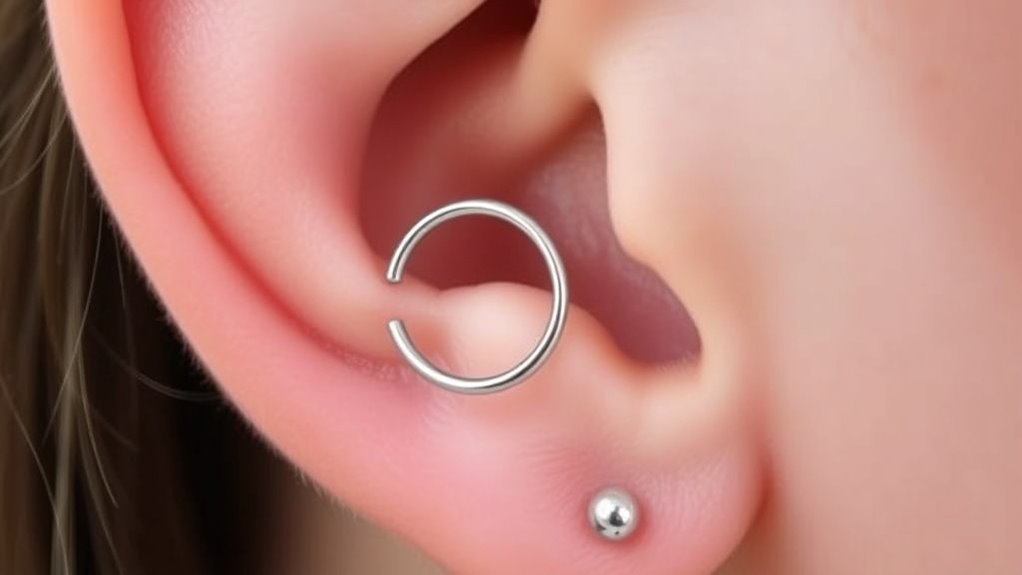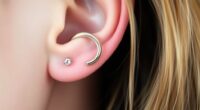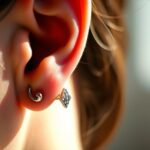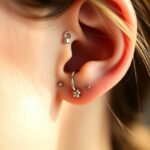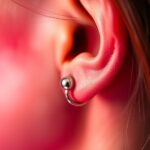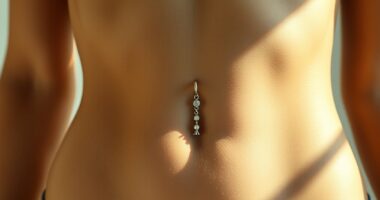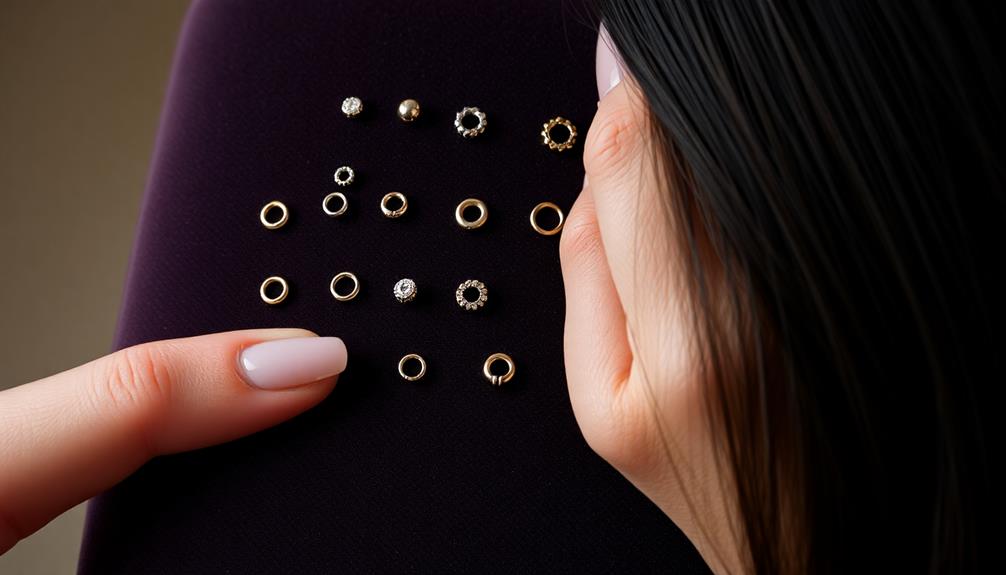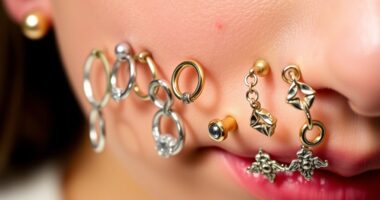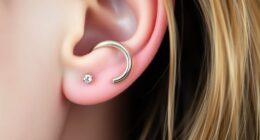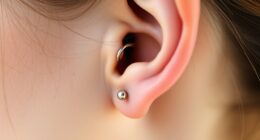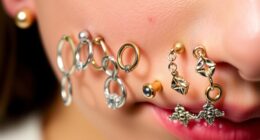Helix and forward helix piercings are trendy cartilage piercings located along the upper rim of your ear. The helix runs around the outer edge, while the forward helix sits at the front of the rim near your face. You can choose from hoops, studs, or rings, often made of surgical steel, titanium, or gold. Healing takes several months, so proper aftercare is key. Keep exploring to discover more about these stylish piercings and how to care for them.
Key Takeaways
- Helix piercings are placed along the outer rim of the upper ear, while forward helix piercings are at the front near the face.
- Both piercings are made in the ear’s cartilage and are popular for their stylish and distinct placement.
- Healing times range from 3 to 9 months, with proper aftercare essential to prevent complications.
- Jewelry options include hoops, studs, and captive bead rings, made from materials like surgical steel, titanium, or gold.
- Choosing smooth, subtle jewelry can reduce irritation during healing, while bold styles express personal style.
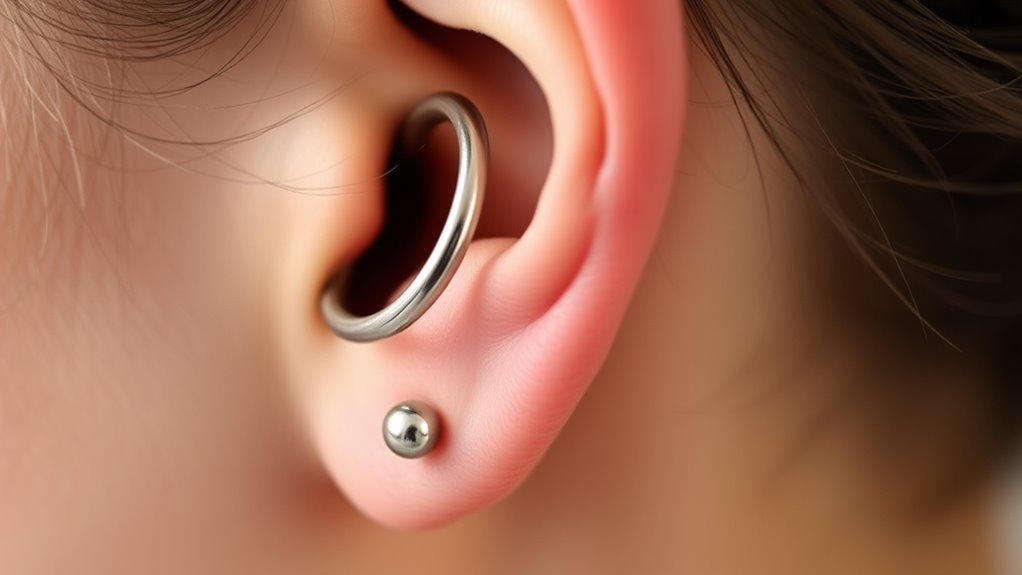
Have you ever wondered what piercings really involve? When it comes to helix and forward helix piercings, understanding the details can help you make informed choices about getting pierced and caring for your new jewelry. These piercings are located on the upper part of your ear, with the helix piercing running along the outer rim and the forward helix situated at the front of that rim near the face. Both are popular for their stylish appeal, but each has its unique placement and jewelry options.
Jewelry styles for helix and forward helix piercings are diverse, giving you plenty of ways to personalize your look. Common choices include hoops, studs, and captive bead rings, which can range from subtle and minimalist to bold and decorative. Because these piercings are on the ear’s cartilage, most jewelry is made from materials like surgical steel, titanium, or gold to minimize irritation. The jewelry you choose influences not only your aesthetic but also your comfort, especially during the healing process. Different styles can affect how quickly your piercing heals and how it feels during daily activities.
Healing processes for helix and forward helix piercings typically take longer than earlobe piercings, often between three to nine months. Cartilage is more delicate and has less blood supply than soft tissue, making it more prone to swelling, tenderness, and infection. During the healing period, you should avoid touching or twisting your jewelry unnecessarily and keep the area clean with saline solutions. Be patient; healing can be unpredictable, and rushing the process can lead to complications like bumps or keloids. Proper aftercare is vital, and it’s essential to follow your piercer’s instructions carefully to prevent infection and guarantee the piercing heals smoothly. Additionally, selecting the right jewelry material can significantly reduce irritation and promote faster healing.
You might find that choosing the right jewelry style can ease the healing process, as some designs are more comfortable and less likely to cause irritation. For example, small studs or hoops with smooth edges tend to be less disruptive during healing. Additionally, the style of jewelry can influence how visible your piercing is, allowing you to express your personality subtly or make a bold statement. As your piercing heals, you may want to switch styles or add decorative pieces that match your evolving taste.
Frequently Asked Questions
How Long Does Each Piercing Take to Fully Heal?
You can expect helix piercings to fully heal in about 6 to 12 months, while forward helix piercings usually take 8 to 16 months. Healing timelines vary based on your piercing aftercare and how well you follow instructions. To guarantee proper healing, keep the area clean, avoid touching or twisting, and use recommended products. Patience and consistent aftercare are key to a smooth, successful healing process.
Are There Any Risks Specific to Helix Piercings?
You should know that helix piercings carry about a 15% infection risk if not cared for properly. There’s also a chance of cartilage damage, which can lead to complications or prolonged healing. To minimize these risks, follow good hygiene practices and choose a professional piercer. Be aware that improper aftercare or an unsterile environment increases the chances of infection and lasting damage, so always prioritize safety.
Can I Switch Jewelry Immediately After Piercing?
You shouldn’t switch jewelry immediately after getting your helix or forward helix piercing. Your ears need time to heal, typically several months, depending on healing timelines. During this period, use jewelry materials like surgical steel or titanium to reduce irritation. Switching jewelry too soon can cause infections or delay healing. Wait until your piercings are fully healed, and then carefully choose high-quality jewelry to avoid complications.
What Types of Jewelry Are Best for Helix and Forward Helix?
Choosing jewelry for your helix and forward helix is like picking the perfect puzzle pieces. Opt for versatile cartilage hoop options or sleek ear cuff styles that complement your look. These pieces stay secure and highlight your piercing’s elegance. Metal options like surgical steel, gold, or titanium are best, especially during healing. Picking the right jewelry guarantees your piercing stays stylish and comfortable as you show off your unique ear art.
How Should I Care for My New Helix Piercing?
To care for your new helix piercing, follow strict aftercare routines and focus on infection prevention. Clean it twice daily with saline solution, gently removing any crust or debris. Avoid touching it with unwashed hands, and steer clear of swimming or exposing it to irritants. Keep the jewelry in place, and don’t pick at scabs. Proper care guarantees quicker healing and reduces the risk of infection.
Conclusion
Now that you know about helix and forward helix piercings, you can decide which suits your style, which reflects your personality, which enhances your look. Whether you choose the elegant curve of the helix or the bold statement of the forward helix, you’re embracing a form of self-expression, a way to stand out, a chance to shine. So go ahead, explore your options, and let your piercings tell your story with confidence and flair.
Piecing together a life one day at a time, that’s me. I’m Rusty, and I love being editor-in-chief of creative piercing. It’s my passion to help others see their vision and bring it to life. When I’m not working or taking care of my family, you can find me reading a good book or eating pie (of course!).

